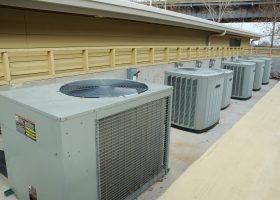Understanding the key distinctions between Variable Refrigerant Flow (VRF) and Variable Air Volume (VAV) systems is pivotal for anyone looking to make an informed decision about their HVAC needs. Whether for commercial or residential applications, choosing the right system can lead to considerable energy savings, improved comfort, and better control over your environment.

VRF Systems: Tailored Comfort and High Efficiency
VRF systems, also known as Variable Refrigerant Volume (VRV) systems, represent a significant advancement in air conditioning technology. These systems use refrigerant as the cooling and heating medium, which is controlled by a sophisticated system that allows for precise temperature control in multiple zones or rooms within a building. This is achieved through the use of outdoor units connected to multiple indoor units, each capable of operating at individual capacities.
The key advantages of VRF systems include enhanced energy efficiency, due to their ability to operate at varying speeds and only use the amount of refrigerant needed for the current conditions. They offer exceptional zonal control, allowing for different temperatures in different spaces, which is ideal for buildings with varying occupancy or usage patterns. Additionally, VRF systems tend to operate quietly and can offer both heating and cooling simultaneously in different zones.
VAV Systems: Simplicity and Flexibility
On the other hand, VAV systems control the temperature of a space by varying the flow of air to different areas, while maintaining a consistent temperature. This is typically achieved using a central air handler that supplies air through ductwork, with VAV boxes located throughout the building to regulate the volume of air delivered to each zone. The temperature is controlled at the central unit, making this system more straightforward but slightly less flexible than VRF systems regarding individual room control.
VAV systems are lauded for their ability to efficiently handle varying loads within large buildings and are generally simpler and less expensive to install and maintain compared to VRF systems. They are particularly effective in environments where the air temperature can be constant, but the amount of air flow needs to vary to meet different cooling or heating demands.
Making the Right Choice for Your Building
Deciding between a VRF and a VAV system largely depends on the specific needs of your facility, including size, layout, and the level of control desired in different areas. VRF systems might be the better option for buildings with high variability in room occupancy and usage, offering superior energy efficiency and comfort through customized temperature control. VAV systems, however, may be suited for larger spaces with more uniform temperature preferences, where simplicity and lower upfront costs are prioritized.
Turn to All Seasons Inc. for Expert Guidance
In determining the ideal HVAC solution for your space, the expertise offered by All Seasons Inc. can be invaluable. With a comprehensive understanding of both VRF and VAV systems, our skilled technicians can assess your specific needs and recommend the most appropriate and energy-efficient system for your situation.
Need VAV or VRF System Service?
If you’re considering upgrading your HVAC system or need professional advice on the best system for your new project, All Seasons Inc. is here to help. Reach out to us to explore your options, and let our experts guide you to the perfect solution for your Tacoma, WA property. Contact the experts at All Seasons Inc. Call us at (253) 879-9144 or fill out our online form to schedule a consultation today.
















